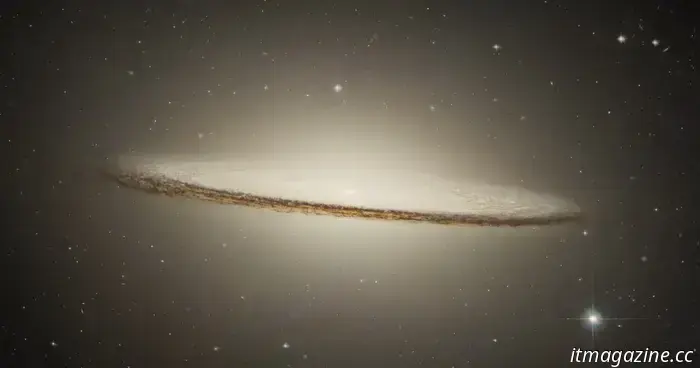
Hubble photographs a galactic hat to celebrate its anniversary.
Positioned about 30 million light-years away in the Virgo constellation, the Sombrero Galaxy is easily identifiable. When viewed nearly edge-on, the galaxy’s gently glowing bulge and sharply defined disc resemble the rounded crown and wide brim of a Mexican hat, from which it derives its name.
A freshly released image from the Hubble Space Telescope captures the attractive Sombrero Galaxy, so named due to its likeness to the traditional Mexican hat.
This galaxy may look familiar, as it is quite famous and has been previously captured by the James Webb Space Telescope. While Webb observes in infrared wavelengths, Hubble primarily focuses on visible light, resulting in differing perspectives of the same object. In this instance, Webb’s picture of the Sombrero exposes more of the galaxy's internal structure, whereas Hubble’s photograph highlights the luminous dust clouds forming the disc.
Hubble has also taken images of this galaxy before, as early as 2003. However, the latest image employs advanced processing methods to reveal additional details in the galaxy’s disc, along with more stars and galaxies in the background. Hubble scientists opted to revisit this galaxy to celebrate the observatory's 35th birthday, due to its popularity among amateur astronomers. Even novice astronomers equipped with basic telescopes can observe this galaxy, and its unique silhouette has captivated skywatchers for decades.
“The galaxy is too faint to be seen without visual aids, but it is easily observable with a decent amateur telescope,” Hubble scientists state. “From Earth, the galaxy occupies an expanse roughly one-third the diameter of the full Moon. Its size is too extensive to fit within Hubble’s narrow field of view, which is why this image is a mosaic composed of several stitched photographs.”
The galaxy's distinctive appearance is attributed to the angle from which we view it. Typically, spiral galaxies are seen face-on, appearing circular and displaying arms extending from the center. However, this galaxy is seen at an angle of just 6 degrees off the central equator, giving it a wide and flat look. Beyond creating a striking visual, this angle enables scientists to observe the galactic bulge at the center and the surrounding dust ring near the galaxy’s edge.
Nevertheless, this observational angle leaves the galaxy somewhat enigmatic. It remains unclear whether the Sombrero possesses spiral arms like our Milky Way or if it is a more nebulous type known as an elliptical galaxy. Regardless, from Earth's perspective, it stands as a remarkable and beautiful object, well worth searching for if you ever use a telescope at home.
Georgina has been a space writer for Digital Trends for six years, focusing on human space exploration and planetary…
Hubble captures an image of a stunning ‘stellar volcano’
A striking photograph from the Hubble Space Telescope depicts a nearby star known as R Aquarii, which is characterized by intense activity: explosive eruptions of matter ejected into surrounding space. Nicknamed a "stellar volcano" for its behavior resembling lava erupting from underground, the star presents a breathtaking image, but it also harbors an unexpected twist—it is not a single star, but a pair.
Identified as a symbiotic variable star, it consists of a red giant and a white dwarf that continually orbit each other. The red giant fluctuates, with its temperature and brightness varying over a 390-day cycle. This coincides with the 44-year orbital cycle of the white dwarf. When the white dwarf gets close to the red giant, it siphons some of its gas through gravitational pull and accumulates a disk around it until the disk collapses and detonates, ejecting jets of material. This cycle repeats itself thereafter.
James Webb Telescope reveals a beautiful galaxy with a monstrous presence at its core
A recent image from the James Webb Space Telescope showcases a nearby galaxy called Messier 106, a notably bright spiral galaxy. At merely 23 million light-years away, this galaxy draws particular interest from astronomers because of its active central region, known as an active galactic nucleus.
The heightened activity in this central area is believed to stem from a monster that resides at the galaxy's core. Like many other galaxies, including our Milky Way, Messier 106 has a supermassive black hole at its center. However, the black hole in Messier 106 is especially dynamic, consuming matter like dust and gas from its surroundings. In fact, this black hole devours so much material that as it rotates, it distorts the gas disk around it, creating streams of gas projecting out from this central region.
Hubble captures an image of a pair of diminutive dwarf galaxies
A new photograph from the Hubble Space Telescope highlights a small dwarf galaxy known as IC 3430, located 45 million light-years away. This galaxy is categorized both as a dwarf galaxy due to its small size and as an elliptical galaxy due to its shape.
Elliptical galaxies are typically smooth and featureless, appearing blob-like and





Other articles
 The trailer for season 2 of Poker Face teases the comeback of Charlie Cale, portrayed by Natasha Lyonne.
Natasha Lyonne is back as Charlie Cale in the official trailer for the new season of Poker Face, set to return to Peacock in May.
The trailer for season 2 of Poker Face teases the comeback of Charlie Cale, portrayed by Natasha Lyonne.
Natasha Lyonne is back as Charlie Cale in the official trailer for the new season of Poker Face, set to return to Peacock in May.
 These four new features from Deezer outpace those of Spotify.
new features on Deezer
These four new features from Deezer outpace those of Spotify.
new features on Deezer
 Mario Kart World Direct: When and where to tune in
Nintendo is set to hold a brief Direct focused on Mario Kart World. Here's how you can watch it.
Mario Kart World Direct: When and where to tune in
Nintendo is set to hold a brief Direct focused on Mario Kart World. Here's how you can watch it.
 Ninja Gaiden: Ragebound serves as a strong reminder that 2D games continue to dominate.
Ninja Gaiden: Ragebound is a intense return to retro gaming, featuring a few refreshing elements.
Ninja Gaiden: Ragebound serves as a strong reminder that 2D games continue to dominate.
Ninja Gaiden: Ragebound is a intense return to retro gaming, featuring a few refreshing elements.
 Trump's tariffs revive Europe's drive for cloud sovereignty.
According to Mark Boost from CIVO, Trump's tariffs have "solidified the notion" that Europe cannot depend on the United States for its digital infrastructure.
Trump's tariffs revive Europe's drive for cloud sovereignty.
According to Mark Boost from CIVO, Trump's tariffs have "solidified the notion" that Europe cannot depend on the United States for its digital infrastructure.
Hubble photographs a galactic hat to celebrate its anniversary.
The Hubble Space Telescope has captured a new image of a cosmic hat.
